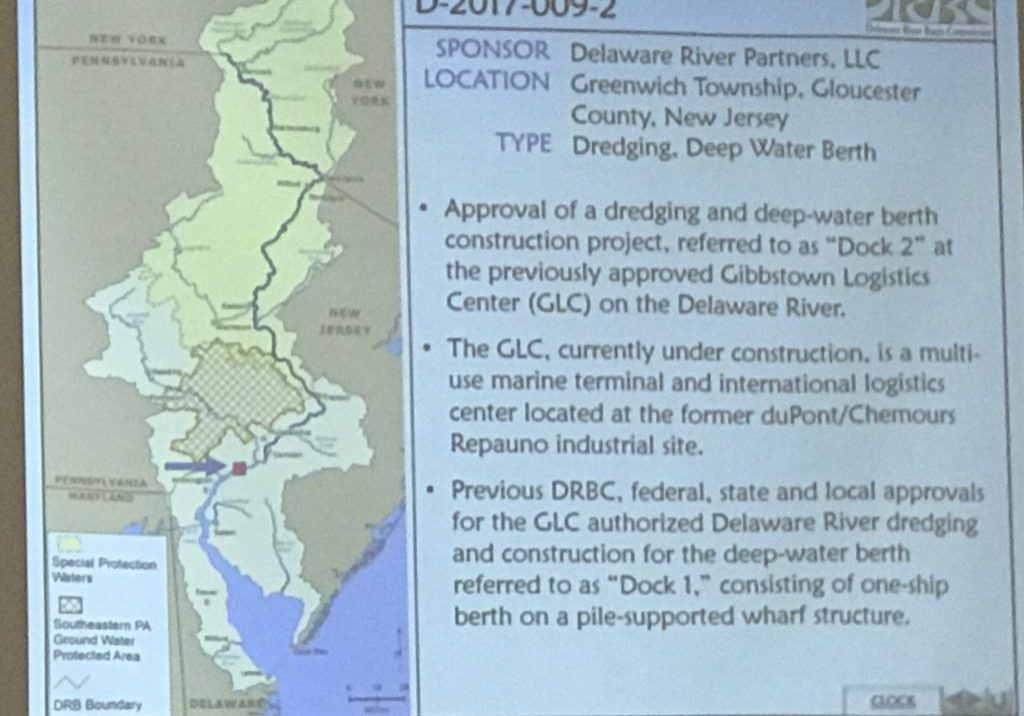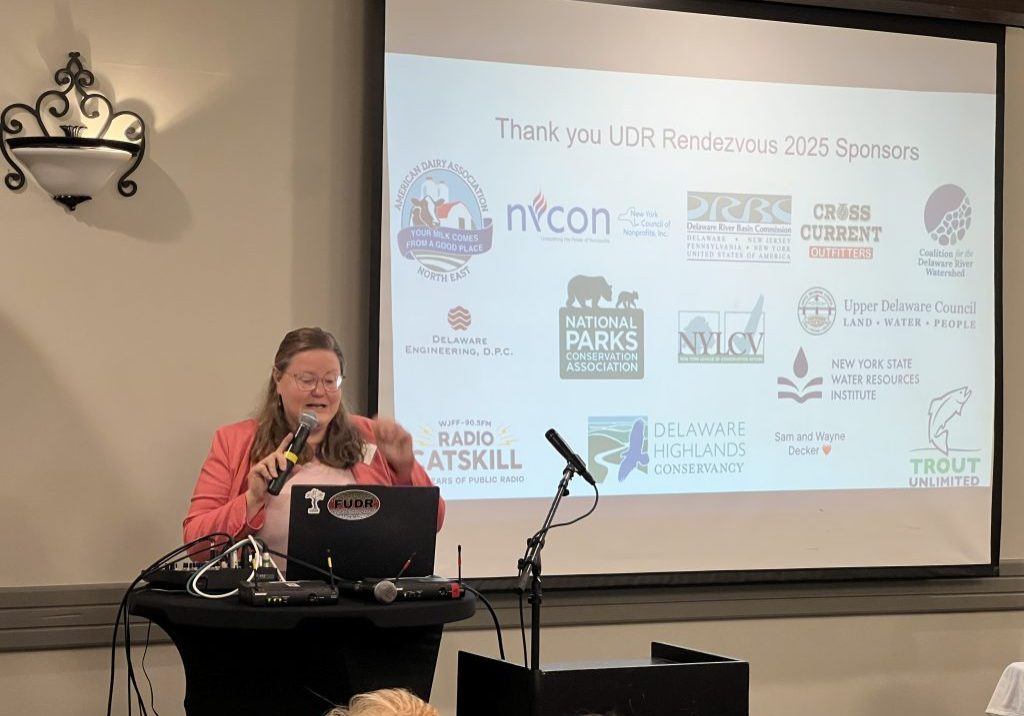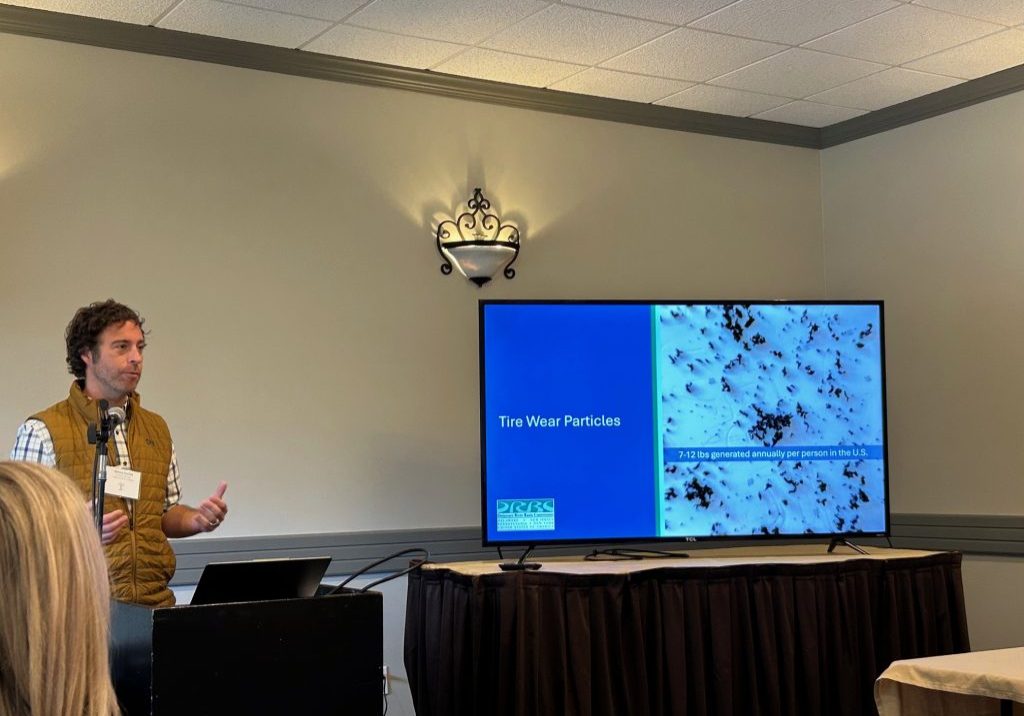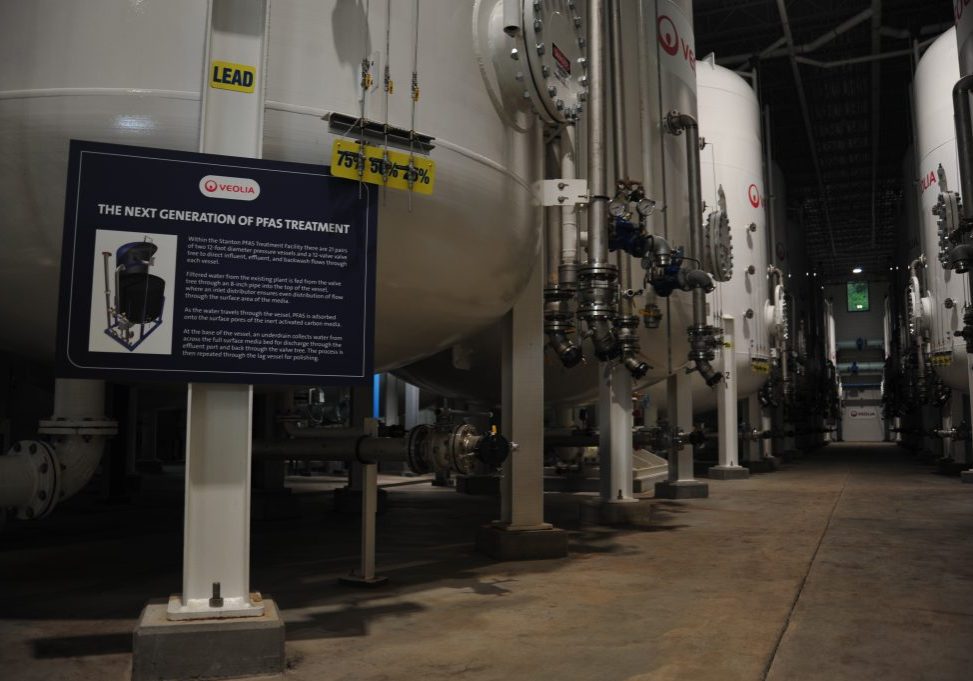
Important issues facing the Delaware River basin in 2017
| January 19, 2017
SEVERAL YEARS AGO, the Delaware River Basin Commission postponed adopting regulations regarding gas drilling (fracking) in the basin. “The special meeting scheduled for Nov. 21, 2011 to consider adoption of the revised draft natural gas development regulations was postponed to allow additional time for review by the five DRBC members.” That’s what it says on the DRBC website. Until those regulations are forthcoming, there’s no fracking in the basin. But it’s not a ban, really, and it might not even be called a moratorium, at least it hasn’t been called that by the DRBC. Many are happy enough that there’s at least a pause in natural gas drilling until we see what its effect might be – especially since more than 15 million people rely on the waters of the basin. And the Marcellus Shale formation, which is where the gas is trapped that fracking will release, underlies about 35% of the basin. Others are not so happy. On May 17, 2016, Wayne Land and Mineral Group, LLC filed a complaint against the Delaware River Basin Commission (DRBC) in federal district court, charging that the DRBC has acted beyond its regulatory commission. The DRBC hasn’t commented on the suit, but gives this information on its website: “The U.S. District Court for the Middle District of Pennsylvania will hold oral argument and a plenary hearing on DRBC’s motion to dismiss on Jan. 24th at 10:30 a.m. The courtroom is still to be designated by the Clerk of the Court.” An unexpected wrinkle happened in November when three Pennsylvania senators filed to join the lawsuit: Sen. Lisa Baker, R-Lehman Township; Senate President Pro Tempore Joseph Scarnati, R-Jefferson County: and Sen. Gene Yaw, R-Williamsport. And here’s a wrinkle in that wrinkle: early in the new year, the federal court has denied the senators’ motion to join the case. The court, though, is allowing the senators to file a friend-of-the-court brief. So, where there’s talk of fracking, there must be talk of pipelines Time was, if a legislator was known for bringing power to his communities, he received general gratitude. President Lyndon B. Johnson used that gratitude as his power base a long time ago when he helped bring electricity to rural Texas. Now? Fracking in a community is as likely to divide it as unify it. The pipelines that carry that fracked gas are a bigger problem in that those pipelines benefit, almost by definition, people who don’t live where the pipelines are dug. The benefit of that power is felt far away in power-hungry cities. Time was, power was so important to most people that figuring out how to get enough power was considered “Job 1.” So the Federal Energy Regulatory Commission seems to have operated on the general principle that its job is to allow, maybe encourage, large interstate pipelines to be built, like Penn East. PennEast Pipeline is planned to carry fracked gas from Dallas, Luzerne County, in northeastern Pennsylvania, to Transco’s pipeline interconnection near Pennington, Mercer County, New Jersey. Approvals for a pipeline are complicated, and vary from state to state, but it seems that Pennsylvania and New Jersey can have a say in it, as well as the Delaware River Basin Commission. The DRBC has some responsibility since the pipeline is due to cross under the Delaware River somewhere south of Easton, Pa. in a small town called Riegelsville. At least that where it was planned to cross. Then the folks in New Jersey noticed what was coming and started fighting back. Now there is a proposal from PennEast to change the route so that the pipeline will avoid the headache of activists in the Lambertville area of New Jersey, introducing two more river crossings. Three crossings: We would have the initial crossing from Pa. in Riegelsille to New Jersey, then cross the river back into Pa. and then back into New Jersey, closer to where it would end. Here’s a map of all possible proposed routes:
These changes bring up an interesting point: If you’re middle class and know how to reach and push the levers of power you can bend the plans of the mighty. But what about the people on the other side of the river? Less inclined to fight? Less prepared to fight? Maybe. Maybe not. These sorts of questions become a social justice issue – we often put the unsightly, unhealthy apparatus of our modern world where the middle and upper classes don’t have to deal with it. Anyway, this is certainly a situation to watch, since the PennEast Pipeline website expects FERC to rule in 2017 with construction beginning in 2018. Oh and don’t forget another pipeline, part of which is in the watershed but doesn’t cross the river -the Millenium Pipeline. It originates in Greenwood, N.Y. and ends in Bowline, right on the shore of the Hudson River north of Haverstraw. The Millenium Pipeline has been up and running for a while, the newest sources of concern for some residents are two improvements: the Eastern System Upgrade and the Valley Lateral Project. The Delaware Riverkeeper asked the DRBC to review these projects and the DRBC has said that it does not consider these pipeline improvements to be under its jurisdiction. Could be that its hands were tied since FERC (remember FERC?) has already given its blessing. There’s an informational meeting organized by the Delaware Riverkeeper if you want to know more about this: February 4, at 10 am, at the Highland Town Hall in Eldred, N.Y. Can you stand one more pipeline? This one is way down in South Jersey, and it crosses the Pinelands. It’s called either the Pinelands Pipeline or the South Jersey Gas Pipeline. And if you don’t know the Pinelands, let’s ask Wkipedia: “The Pine Barrens is a heavily forested area of coastal plain stretching across more than seven counties of southern New Jersey.” Now, water nerds take note of this part: “The Pine Barrens territory helps recharge the 17 trillion gallon Kirkwood-Cohansey aquifercontaining some of the purest water in the United States. As a result of all these factors, in 1978 Congress passed legislation to designate 1.1 million acres (4,500 km²) of the Pine Barrens as the Pinelands National Reserve (the nation’s first National Reserve) to preserve its ecology. A decade later, it was designated by the United Nations as an International Biosphere Reserve.” This 21.6 mile pipeline doesn’t traverse the Delaware River, but its importance lies in its aquifer. The pipeline would cross the Pinelands Forest Area of Cumberland and Cape May Counties – a planning district where this kind of infrastructure is forbidden unless it is primarily serves people living inside Pinelands already – in order to bring natural gas to the BL England Power plant on the shores of Great Egg Harbor, N.J. The history on this one is so complicated that it’s almost comical, so if you’re interested, I’d suggest reading this story from Shore News Today. If you’re not in Scranton for the fracking hearing, you could go to the public hearing on this – it’s also on Jan. 24th at 9:30 a.m. at the Ocean Acres Community Center in Stafford Township, the land side of New Jersey’s Long Beach Island. Plus side – you’d be near the beach. On the other, hand it IS January! Science in the Delaware River and Bay This one is still on the beach and in January but worth noting because it’s a science conference all about the Delaware. The Delaware Estuary Science and Environmental Summit is in Cape May from Jan 22-25. (And this is why I won’t be at either the Scranton hearing or the public hearing on the Pinelands Pipeline.) Organized by the Partnership for the Delaware Estuary, the summit is held every other year. “The Delaware River and Bay are divided among four states, so it’s really important we get folks on all sides collaborating,” said Jennifer Adkins, executive director of the PDE. “We feel we’re best suited to do that, because we’re the only organization focused on the entire environment affecting the tidal river and bay.” This quote is taken from an article about the Summit from the Press of Atlantic City. You can read more here. Dredging and the ports on the Delaware The dredging – or deepening- of the Delaware River is due to be completed in 2018. The dredging was done in response to the planned, and now completed, expansion of the Panama Canal. Here’s a story. The project will continue to be a source of conflicting optimism and pessimism. For a change, the conflicts are not along the typical environmental vs. economic issues. There is a possibility of more jobs and economic growth in Delaware River ports, but experts don’t all agree that it’s a slam dunk since all of the other ports on the East Coast are engaged in the same process in hopes to win the business of the super cargo carriers. More about that here. Environmentalists are concerned about what harmful chemicals might be re-released into the water as a result of the dredging, like PCBs. (Chemicals were once freely disposed of in the river, eventually getting trapped in the sediment.) In additional, dredging combined with the effects of climate change, could allow more ocean water, which is salty, to get upriver further and faster. And that could have an impact on the water intakes for Pennsylvania and New Jersey, as well as altering the river’s ecosystem. So was the port of Philadelphia, but it suspended its plans for a new port facility at the Southport site, in favor of boosting capacity at its existing sites. Those new cargo ships need different, expensive equipment to load and unload. More here.  Flying High Of all things to look out for in the Delaware River basin, possible the most delightful are the bald eagles which now nest and fly in the Upper Delaware. In the winter, the population expands with eagles coming south looking for open waters to hunt. If you’re interested. check out all the great eagle-watching support that the Delaware Highlands Conservancy gives to even the rankest amateur bird watcher. They train a good number of volunteers who man various sites in the Upper Delaware with great scopes that can give you a really close up look at these magnificent birds – which otherwise are just some dots in the sky. And they know the difference among the many birds and will help you find an actual eagle to sight and brag about. I went on one of their tours last year and saw eight eagles – I was like the proverbial kid in the candy shop! Check out this website. Phase 2, Delaware River Watershed Initiative All year long, non-profits and academics all over the basin will be preparing for the second stage of the William Penn inspired (and largely funded) initiative, which has as its goal the restoration and preservation of clean water in the Delaware. My much-smaller goal is to write about it in a way that doesn’t sound like a term paper! It is massive and important. So stay tuned … sometime in 2017 it will appear!! So, not last and not least: Delaware Toward the end of 2016, Delaware’s Department of Natural Resources and Environmental Control approved a plan to ship unblended ethanol from the Delaware City Refinery, owned by PBF Energy. This caused dismay in the Delaware environmental community, which thinks that this flies in the face of protections promised by Delaware’s Coastal Zone Act. Think of this as yet another story about power, not fracking but ethanol processing and shipment. Delawareonline.com – the online version of The News Journal (Wilmington, DE) – has carried informative stories about this: We’ll see if the new governor, John Carney, intends to be more observant of environmentalists’ sensitivities. After all, he was one of the main forces behind Congressional approval of the Delaware River Basin Conservation Act.
Flying High Of all things to look out for in the Delaware River basin, possible the most delightful are the bald eagles which now nest and fly in the Upper Delaware. In the winter, the population expands with eagles coming south looking for open waters to hunt. If you’re interested. check out all the great eagle-watching support that the Delaware Highlands Conservancy gives to even the rankest amateur bird watcher. They train a good number of volunteers who man various sites in the Upper Delaware with great scopes that can give you a really close up look at these magnificent birds – which otherwise are just some dots in the sky. And they know the difference among the many birds and will help you find an actual eagle to sight and brag about. I went on one of their tours last year and saw eight eagles – I was like the proverbial kid in the candy shop! Check out this website. Phase 2, Delaware River Watershed Initiative All year long, non-profits and academics all over the basin will be preparing for the second stage of the William Penn inspired (and largely funded) initiative, which has as its goal the restoration and preservation of clean water in the Delaware. My much-smaller goal is to write about it in a way that doesn’t sound like a term paper! It is massive and important. So stay tuned … sometime in 2017 it will appear!! So, not last and not least: Delaware Toward the end of 2016, Delaware’s Department of Natural Resources and Environmental Control approved a plan to ship unblended ethanol from the Delaware City Refinery, owned by PBF Energy. This caused dismay in the Delaware environmental community, which thinks that this flies in the face of protections promised by Delaware’s Coastal Zone Act. Think of this as yet another story about power, not fracking but ethanol processing and shipment. Delawareonline.com – the online version of The News Journal (Wilmington, DE) – has carried informative stories about this: We’ll see if the new governor, John Carney, intends to be more observant of environmentalists’ sensitivities. After all, he was one of the main forces behind Congressional approval of the Delaware River Basin Conservation Act.







